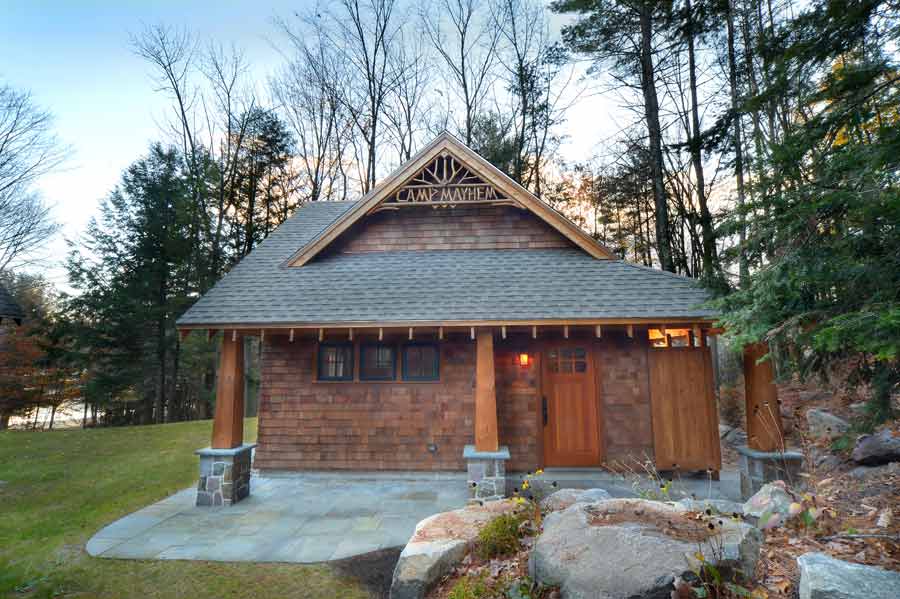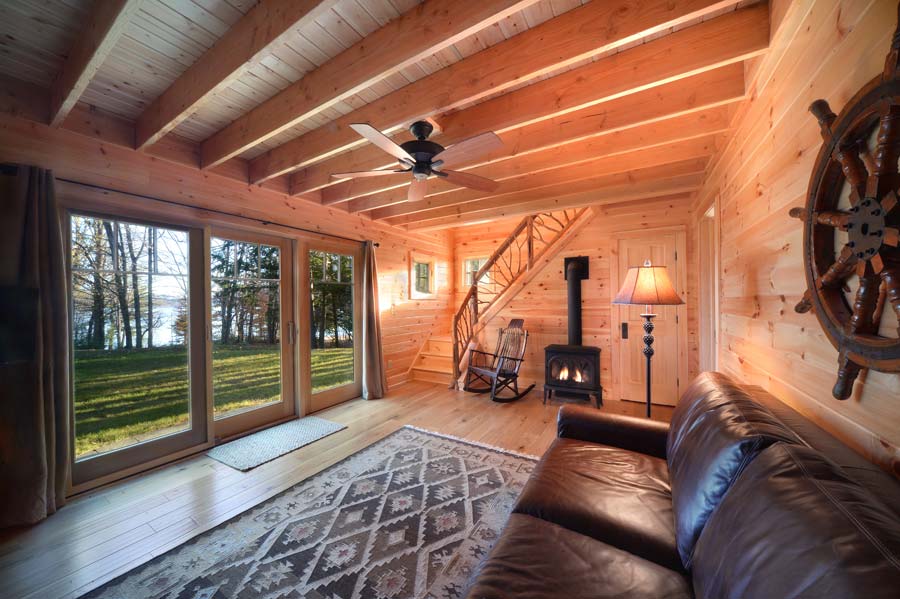When Mary Beth Walsh was a little girl, her father stuck a pin in a map where their Latham home lay. Then he drew a circle describing a 50-mile radius. He told the family that their new summer house had to be in the circle, because “this is how long I can stand to be in the car with all you guys.”
It was the 1960s, and they found the perfect spot near the shoreline of the Great Sacandaga Lake, a 29-mile long reservoir created in the Adirondack Park in 1929 by the construction of the Conklingville Dam. The three-bedroom structure cost about $7,000, or maybe $9,000, Mary Beth remembers, and was the kind of summer camp that you shuttered in the fall and checked on once during the winter to make sure the roof didn’t cave in under the snow.
By the time Mary Beth was a grown up lawyer, the cottage had been shared for decades by the members of the extended family. It was starting to show signs of wear, and major repairs were needed. Cognizant that parcels so near the water with deeded beach rights are much harder to come by these days, Mary Beth decided to take on the expense of winterizing the home and adding a second story loft.
Then came divorce, and later, happily, a new chapter.
“After my divorce, I started to date a man with four children, and I had two children, so together, we had six children, now between the ages of 22 and 8,” Mary Beth said. “Even when we were just starting to date, and the kids were so little, we’d be at my house in Burnt Hills and they were just bouncing off the walls. We’d say, ‘Welcome to Camp Mayhem!’”
(And yes, in case the scenario sounds familiar, they’ve already sent a photo Christmas card modeled on the Brady Bunch.)
With six kids, the old camp started to be just a little bit cramped. They’d throw down air mattresses and “the kids would always fight over who would have to sleep in the loft because it was hot up there and crowded.” When the rest of the family would gather “it was just ridiculous,” Mary Beth laughed. “We were pitching tents, and tripping all over each other.”
About two years ago, Mary Beth decided to surprise her now husband, attorney Jim Walsh, with a stay at the Lake Placid Lodge to celebrate their November birthdays.
“I booked one night and this cabin was just beautiful,” Mary Beth said. “You walked right in to a bed that looked like it was made of whole trees. I’ve always loved rustic furniture. I had already been thinking, ‘Wouldn’t it be nice if we had a little outbuilding to store our boat in the off-season?’ After we stayed at Lake Placid Lodge, I fell in love with the idea of this cabin.”
Having served as a councilwoman in the Town of Ballston and as Town Attorney in Edinburg, Mary Beth knew getting approvals for a second structure on a waterfront lot could be challenging.
“I just wanted the place to be really well done, and I didn’t want the cabin to overwhelm the main cottage. Because of the setbacks and the sand and the hill and the zoning and keeping the neighbors happy — well, I had a lot of faith in Teakwood’s ability to handle all of that. I knew that Jim Sasko and Chris Lamica would know how to remove part of the hill and nestle in the cabin so it had the right relationship to the main cottage.”
Teakwood had already renovated the kitchen in the couple’s primary residence in Burnt Hills, about a 35-minute drive to the southeast.
“Not only do they know my tastes, they have a really good sense of design and what fits,” Mary Beth said. “They don’t just nod their heads and do whatever I tell them. They’ll tell me what will work and won’t work.”
That understanding of the family’s tastes was so on-target that Sasko’s first pass at a design became the vision for the completed camp. Marybeth and Jim loved the sketch and little was done to change the layout or scale.
Planning every day’s construction became a vital task, since there is no cell phone coverage at the camp, and construction began in deep snow and frigid temperatures.
The new cabin is simple, but spectacular, with everything but the kitchen sink. “I wasn’t looking to make a third house to take care of, so we left out the kitchen, and I think that made it easier with the building department,” Mary Beth said. “I just wanted a place where people could relax, that was beautiful and comfortable and peaceful.”
Teakwood used natural materials such as pine paneling, rustic knotty alder cabinetry, local rock, Turkish travertine tile, polished river stones and hand-scraped white oak plank flooring to create a clean, spare template that emphasizes the views of the lake. The shake shingles were imported from British Columbia Canada, one of the best and last sources for true redwood cedar. Each shingle was dipped into a sealer before being placed to ensure the exterior’s longevity.
Teakwood kept the height of the outbuilding low so as not to obstruct views from other dwellings, but created a sense of height and visual interest in the upstairs loft by creative placement of the supporting beams.
“Even when we only have four or five of the kids staying over, they are fighting over who gets to stay up there,” Mary Beth laughed. “You know who hasn’t gotten to sleep in there yet? My husband and I!”
The space is simply furnished, with a comfy pullout couch, some Amish rockers, a roughhewn bed and a propane stove for the cooler nights.
“The best part of the whole project is my husband had the idea to have an outdoor shower,” Mary Beth said. “I was thinking, I don’t want to take a shower outside in the cold. But it’s got its own little water heater, and it’s the most wonderful thing. Nobody showers in the bathroom in the main house anymore.”
Mary Beth chose an artist from the Adirondack town of Northville—Russ Gleaves—to work with Teakwood on the finishing touches that make the simple cabin unique, yet true to the original inspiration.
Gleaves, the son of a Sacandaga musician who ran a rare book and antiquities shop, specializes in making furniture—such as Adirondack chairs, dining room tables and armoires—from found wood, such as gnarly branches and old canoes. He incorporates the existing shapes into contemporary museum-quality masterpieces, sort of the reverse of a sculptor intuiting the hidden form within a block of marble and coaxing it out.
Gleaves created decorative spindles made of branches for the staircase, the dominant visual when you enter the cabin. For the eaves of the peaked roof, he made sculptures of branches that echo the trees surrounding the cabin. And in one of the sculptures, he incorporated the new name for the addition—naturally, “Camp Mayhem.”






